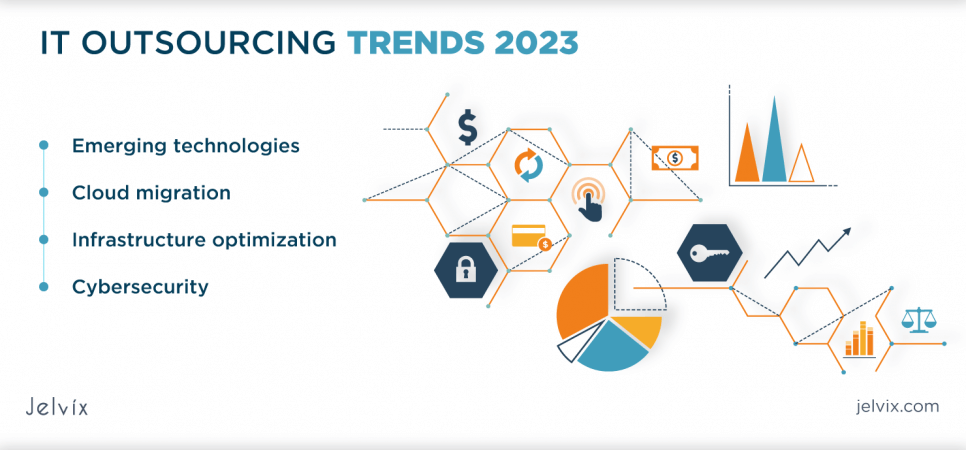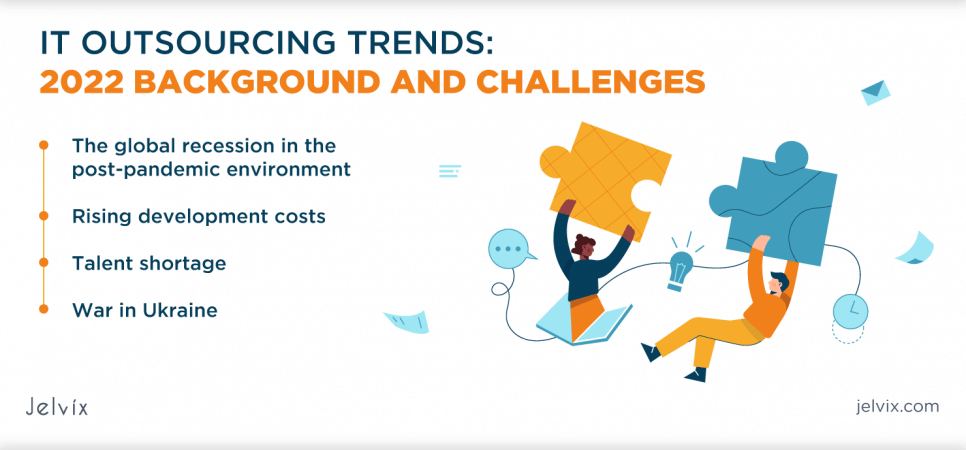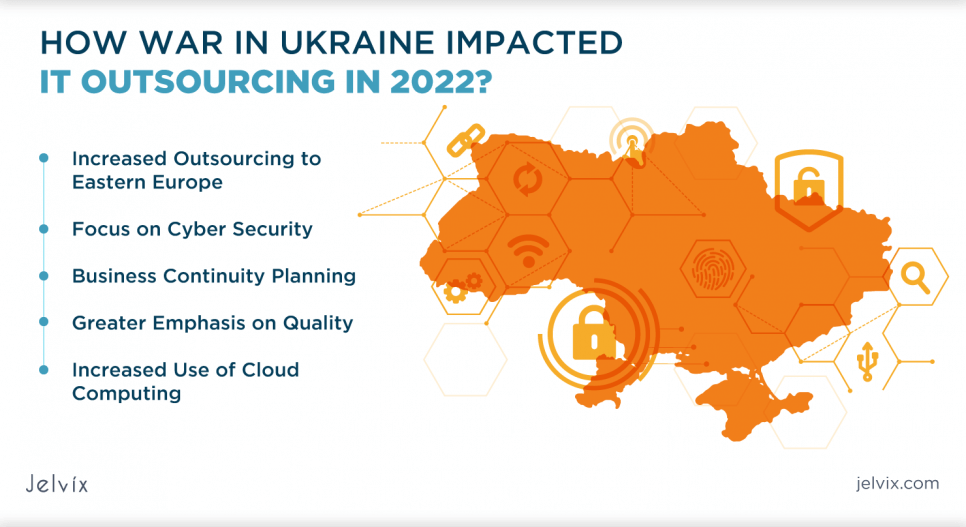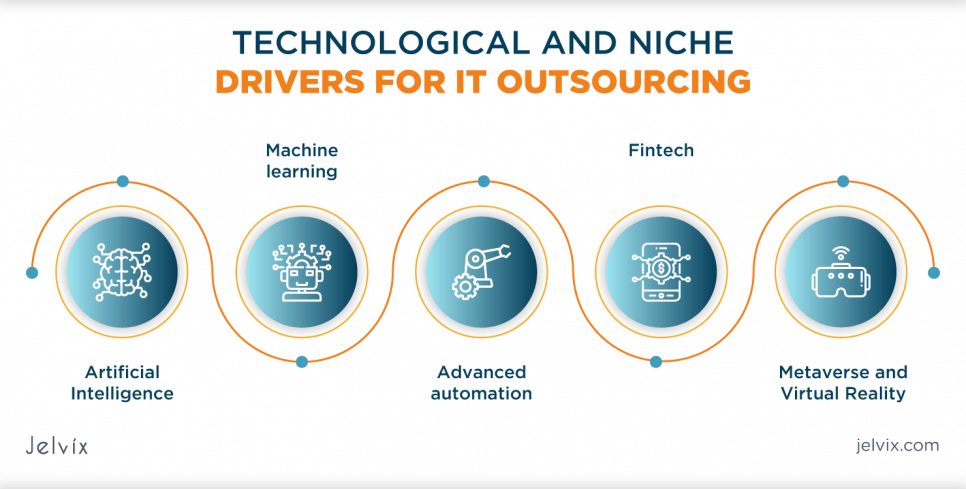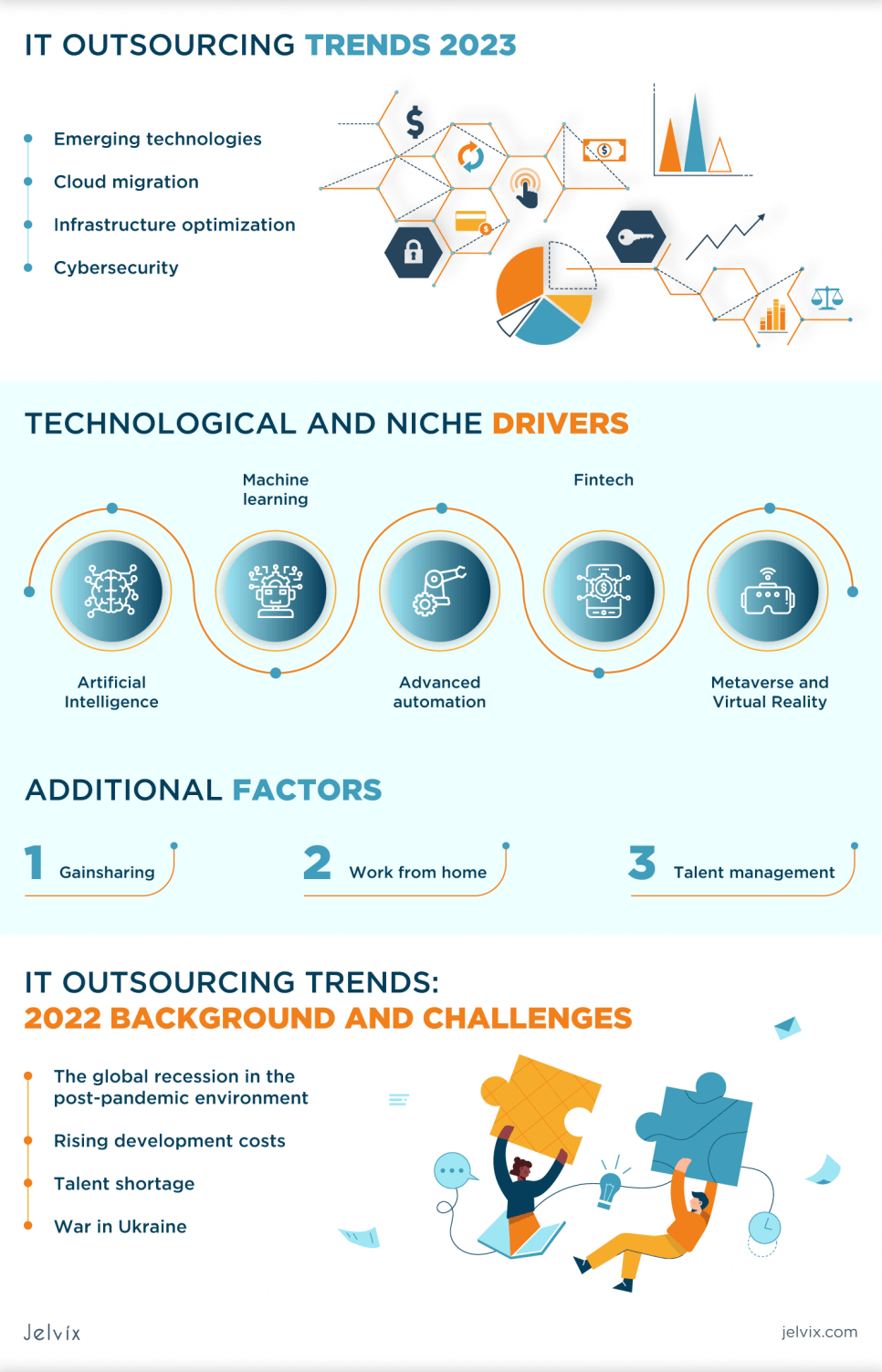When estimating IT outsourcing trends for 2024, several factors must be considered. These aspects include future business process outsourcing trends, technology drivers, and significant challenges. Monitoring the most demanded IT outsourcing services is also essential for such analysis.
Technology companies outsource a number of functions, from recruitment to software development. Outsourcing is a viable option for startups that can’t afford to hire an in-house team of developers or engineers. It’s also an excellent way to keep costs down while allowing businesses to focus on revenue-generating activities, free up resources for task priority, and provide access to world-class technology.
Outsourcing is also a great way to tap into the skills of experts in their field. For decision-makers, outsourcing certain elements or entire departments of a business may be necessary, depending on the company’s needs. By outsourcing, businesses can benefit from access to specialized skills and resources that may only be available in some places. Whether you’re a startup or an established player, outsourcing can help you scale up and stay afloat.
Current IT outsourcing trends: what’s on the agenda
The technology business will likely undergo significant changes in the year ahead. Hundreds of companies and whole sectors are in the process of changing their practices, focusing on scalability, quality, agility, and customization. Besides, several major drivers influence the latest IT outsourcing trends, including cloud migration, the digital economy, and emerging new technologies.
These shifts are forcing companies to change how they make technology purchasing decisions, creating a dilemma for decision-makers whether to hire more in-house IT professionals or outsource projects and tasks to external software developers. The answer is a greater need for skills and a larger role for software acumen. Despite all these challenges, there are lots of companies ready to invest in technology in 2024.
If you are an IT manager, you already know how important it is to keep up to date with the latest trends in IT outsourcing. You know that by outsourcing your IT infrastructure, you will be able to reduce your costs and improve your efficiency. IT outsourcing can help businesses in a variety of ways. For instance, it can free up the in-house team to focus on what they do best rather than on less-essential tasks. As a result, the company’s overall productivity can improve. In addition, it can save time on troubleshooting and maintenance. It can also reduce the cost of training new employees.
Here are several significant drivers for recent IT outsourcing trends.
Emerging technologies
Companies are embracing a more strategic approach to technology, making it a critical component of their business strategy. As more companies look to the cloud, they are adapting their approach, allowing their employees to work more effectively and efficiently. This shift has also allowed for more service-oriented thinking. It is now easier for companies to develop solutions leveraging their data. As technology upgrades, automation is in the pipeline as well. Despite the digital economy’s growth, companies still focus on quality assurance, which is integral to delivering a positive customer experience.
According to a recent survey by CompTIA, 80% of IT professionals are optimistic about the future of their careers. Almost half of these respondents reported being confident about working for large enterprises. And over 71% feel the same at small and mid-sized organizations. While many respondents are worried about their businesses, most IT pros report being optimistic about their careers.
Cloud migration
Cloud adoption is still rising. Nearly half of the respondents plan to spend more on cloud services in the coming year. Most enterprises expect cloud usage to exceed their previous plans. Moreover, the cloud revolution is expected to continue. With this increase in spending, more organizations will migrate their IT functions to the cloud. Moreover, more of them will use Platform as a Service (PaaS), a software-as-a-service solution. PaaS is a popular way for organizations to develop, host, and manage applications without building and maintaining their own.
The emergence of more cloud-based technologies, a plethora of new digital capabilities, and the rise of cloud orchestration influence the latest IT outsourcing trends. This combination creates a unique platform for generating, storing, and leveraging data. Ultimately, these developments enable organizations to develop innovative solutions to enhance their business.
Infrastructure optimization
Another big driver in recent outsourcing trends is business models’ evolution. Historically, the IT function has been considered a cost center. That role has changed as it has moved from managed services to pure consulting. Over the past few years, the technology business has undergone an overhaul, with many firms shifting their business model. For instance, more channel companies are transitioning from a reseller of hardware to full-service providers. Similarly, more organizations are focusing on creating more customized applications.
Other significant drivers for recent outsourcing software development trends include the continued trend toward decoupling applications and infrastructure from each other. This allows IT teams to move their apps to different runtime environments, including public and private cloud and container-based projects. Furthermore, organizations implementing virtual collaboration tools will need a solution to store and access their data and information. A mobile device management (MDM) system will also become a necessity.
Cybersecurity
Outsourcing can also ensure that the system is secure. The latest cybersecurity protocols require implementation, while sensitive users’ data and confidential information must be protected from a growing number of denial-of-service (DoS) attacks. These requirements create an overwhelming demand for cybersecurity professionals, increasing the shortage of qualified individuals. Many companies require cybersecurity talent, and the tech industry is launching hiring initiatives. But with the skills shortage comes some additional challenges for the business.
Cybersecurity jobs are expected to grow faster in the next ten years. This is due in large part to the increasing complexity of threats. The International Information System Security Certification Consortium (IISSC) surveyed the cybersecurity workforce. It found that over a decade, 3.5 million new cybersecurity jobs are expected to be created.
While building an in-house cybersecurity team is only sometimes the best option, outsourcing may be the solution. Outsourcing can help a company hire a cybersecurity team that is faster and more scalable.
General IT outsourcing advantages
- Wider talent source;
- Retention of software developers and other IT specialists;
- Access to skilled specialists in different regions with less competition and income expectations;
- Mitigating employee turnover;
- Better specialization for a specific project;
- Tightening gaps in the specialty of tech skills;
- Ability to hire whole teams for exact specialty;
- Lower costs of offshore teams;
- Validation of hybrid teams;
- Team members work independently from anywhere in the world; the pandemic influenced a surge in the work-from-home rate;
- Cybersecurity. The development of new technologies;
- Risk diversification with multiple outsource partners.
Learn more about the main stages of the product development lifecycle to build a sustainable product.
IT outsourcing trends: 2024 background and challenges
Several crucial factors influenced technology trends in 2024. Historical macroeconomic figures, including 40-year-high inflation in developed countries and the end of the unprecedentedly cheap borrowing funds era, as well as essential geopolitical shifts impacting the bloodiest war in 80 years, exaggerated the post-pandemic background of the global economy.
As a result, the global macroeconomic outlook turned negative. Nevertheless, the IT sector is generally still bullish as the current processes that began during the COVID-19 pandemic in 2024 are in play, fuelling the same drivers that caused the recent surge of digitalization across multiple industries. On top of that, several emerging technologies maintained the recent momentum, creating additional supportive factors for outsourcing trends.
The global recession in the post-pandemic environment
The global recession is not upon us yet, but there are signs of a weakening economy. As global markets and technology become more complex, IT businesses must be prepared for changes. For instance, IT companies need more skilled employees to attract and retain top talent.
Although it’s impossible to predict precisely how the global economy will look in 2024, it’s clear that the world is heading toward economic stagnation. Numerous factors, including financial instability, post-pandemic environment, monetary tightening, and climate change, contribute to this state of affairs.
While the overall trend is toward economic stagnation, it’s essential to recognize that it will not affect all company sectors equally. Despite the global slowdown, there are still plenty of opportunities for the IT sector to thrive and keep the bullish trend in the coming year. Businesses are making IT investments to keep up with a rapidly-changing landscape. Moreover, IT pay is rising to attract and retain new employees. Companies are also investing in digital transformation, and digital marketing is one of the critical issues facing SMBs in 2024.
Rising development costs
Software development costs rise for a variety of reasons, including:
- The increasing complexity of software development. Software development is becoming more complex and diverse, which means that the development cost will increase accordingly. This is happening because of the need for more specialized skills and knowledge, as well as the need to develop more robust and secure software.
- Demand for software development. Businesses continue to rely more heavily on digital solutions, so the market for software development is expected to grow which will result in the increasing need for more software developers and higher costs of hiring them.
- The increasing cost of software development tools and technologies. The technology used for software development advances and, consequently, the cost of the tools and technologies needed for development will also increase.
- The rising cost of training and education. More and more employers require software developers to be certified or have specialized knowledge, so the cost of training and education will also go up.
- Labor costs. As the demand for software developers grows, the cost of labor will also increase due to competition for the best talent.
Talent shortage
There is no denying that IT outsourcing is facing a talent shortage. Companies find it increasingly difficult to find qualified professionals to fill positions in IT outsourcing roles. This talent shortage exists due to several factors, including the increasing demand for IT outsourcing services, a lack of qualified and experienced professionals to fill those roles, the rise of automation and artificial intelligence, and the shift in technology trends driving the need for different skill sets.
Companies are also struggling to keep up with the rapid pace of change in the IT industry, making it even harder to find qualified professionals to fill positions in IT outsourcing roles. In addition, many potential candidates need more skills or experience to meet the job demands.
To combat this talent shortage, companies must ensure they can attract and retain qualified professionals. This includes providing competitive salaries and benefits, offering training and development opportunities, and creating a work environment that is attractive to potential candidates. Additionally, companies should partner with educational institutions to ensure that students are trained in the necessary skills and knowledge to fill IT outsourcing roles.
Finally, companies should be willing to invest in programs that foster and support diversity and inclusivity in the workplace, as this will help to ensure that all potential candidates are being considered.
War in Ukraine
The conflict in Ukraine has been a major challenge for IT outsourcing. Companies have faced many issues due to the war in Ukraine, including disruption of key sources, loss of IT destinations, higher rates, and a shift in the geographics of sources. The war has also led to increased security concerns and the need for companies to prioritize risk management and improved customization to ensure cross-border compliance. As Ukraine continues to be a significant IT outsourcing destination, companies will need to be prepared to adjust to the changing conditions in the region to remain competitive.
How the War in Ukraine Impacted IT Outsourcing in 2024
- Increased Outsourcing to Eastern Europe: in response to the war in Ukraine, many companies are now looking to outsource their IT operations to Eastern European countries such as Bulgaria, Romania, and Poland. These countries offer competitive prices, a skilled labor force, and a more stable environment than Ukraine.
- Focus on Cyber Security: the full-scale invasion of Ukraine has brought cyber security issues to the forefront, with companies now more aware of the need to protect their data and systems. As a result, there is an increased demand for IT companies with expertise in cyber security.
- Business Continuity Planning: companies are now more focused on business continuity planning and are looking to IT outsourcing services to ensure their operations can continue during a crisis.
- Greater Emphasis on Quality: with the heightened awareness of the risks associated with IT outsourcing, companies are now placing a greater emphasis on quality when selecting an IT outsourcing partner.
- Increased Use of Cloud Computing: the war in Ukraine has also driven a greater adoption of cloud computing as companies look to move their data and applications off-site and away from potential threats. This has created a growing demand for IT outsourcing partners with expertise in cloud computing.
Technological and niche drivers for IT outsourcing
The demand for emerging technologies and the growing number of programming languages require further innovation. Here is a list of several emerging technologies and niches attractive for IT company outsourcing in 2024.
Artificial Intelligence
In 2024, Artificial Intelligence (AI) will significantly influence outsourcing trends. AI-driven automation and digital transformation technologies will enable businesses to outsource more tasks to third-party providers, allowing them to focus on core competencies. AI-driven solutions will also help enterprises to reduce costs and increase efficiency. Experienced engineers and software developers should expect increased demand for AI-related skills as more businesses leverage AI to outsource IT tasks.
AI-driven automation will also mean that more creative and strategic jobs such as software development, customer service, and data analysis will be outsourced to third-party providers. Ultimately, AI-driven trends in IT outsourcing will create new opportunities for experienced engineers and software developers to capitalize on.
Machine learning
In the near future, Machine Learning (ML) will be one of the most critical drivers of trends in IT outsourcing. By 2024, ML will have become commonplace, and software developers and engineers will be using ML to automate processes, identify patterns, and increase efficiency. ML will enable companies to outsource more complex tasks and provide solutions to issues that would otherwise require manual intervention. ML will increasingly be used to handle previously too difficult or expensive tasks to outsource.
Additionally, ML will be used to monitor and analyze the performance of outsourced IT services, allowing companies to optimize their operations and develop strategies to meet customer needs better. Finally, ML will be used to analyze data, which will help companies identify new opportunities and better understand customer behavior. In summary, ML will majorly impact IT outsourcing in the coming years, driving trends in automation, monitoring, and data analysis.
Advanced automation
In 2024, advanced automation will play an increasingly crucial role in driving trends in IT outsourcing. Automation can improve efficiency, reduce costs, and increase the quality of IT services. Automation is becoming more advanced and can be used to manage and monitor IT infrastructure, automate workflow processes, and improve security. Automation can also be used in deployment, provisioning, and configuration of IT services and applications.
Furthermore, advanced automation can be used to streamline processes, reduce manual labor, and improve accuracy and productivity. Automation can also improve customer service, reduce downtime, and reduce IT infrastructure costs. Automation can also increase scalability, agility, and flexibility.
Advanced automation will also be used to:
- enhance the security of IT services and applications;
- automate the assessment, analysis, and remediation of security vulnerabilities within IT services and applications;
- reduce the manual effort needed for security tasks, improve response times for security incidents, and detect malicious behavior.
Overall, advanced automation will be a crucial driver in the trend of IT outsourcing in 2024. Experienced engineers and software developers should be aware of the many benefits that advanced automation can provide for their businesses.
Fintech
In the coming years, fintech will be a major driver of trends in IT outsourcing. By 2024, firms will be investing heavily in fintech solutions to stay competitive in the global marketplace. As a result, IT outsourcing providers will need to adapt to meet the specific needs of fintech companies. This will likely include specialized services focusing on areas such as artificial intelligence, big data, blockchain, and cloud computing.
Experienced engineers will be essential in helping IT outsourcing providers meet the needs of fintech companies. Companies must ensure they have access to experienced professionals capable of developing cutting-edge solutions necessary to remain competitive. As a result, IT outsourcing providers should capitalize on the opportunity to provide specialized fintech solutions and services.
Metaverse and Virtual Reality
In 2024, Metaverse and Virtual Reality (VR) technologies are expected to drive significant trends in the IT outsourcing industry. VR is a type of immersive technology that allows users to interact virtually with computer-generated environments, which can be used in various applications. Metaverse is a virtual world that offers users an environment where they can interact with other users and computer-generated characters and explore virtual locations.
These technologies are currently being used to build virtual workspaces where remote employees can collaborate in real-time which makes it easier for companies to access talent from all over the world, as workers do not need to be physically present to collaborate. This can reduce costs, as companies no longer need to pay for expensive office space or travel expenses.
Additionally, these technologies can improve the quality of work that is outsourced, as companies can better monitor the work that is being done, as well as provide feedback to the remote team more quickly. This can help ensure that companies get the best results from their outsourced employees.
Overall, Metaverse and VR technologies are expected to drive significant trends in the outsourcing industry in 2024. Software developers and decision-makers should stay up-to-date on the latest technologies to ensure their business remains competitive.
Additional factors influencing IT outsourcing trends in 2024
Gainsharing
In 2024, gainsharing will be a key driver of trends in outsourcing, with decision-makers increasingly looking to gain shared cost savings, increased efficiency, and improved quality outcomes. Gainsharing is a mechanism through which two parties – the customer and the IT service provider – share any benefits from their relationship. It enables customers to receive an agreed-upon share of the savings generated by their service providers, while service providers are incentivized to provide maximum value and cost savings.
Gainsharing will drive IT outsourcing trends by incentivizing service providers to focus on maximizing cost efficiencies and increasing the quality of service. It will also likely lead to increased transparency and collaboration between customers and service providers, who will be able to share data and best practices to get the most out of the relationship.
In addition, gainsharing will create an environment of trust between customers and service providers, leading to more successful outsourcing relationships. As customers and providers are able to share the benefits of cost savings, they will be more likely to partner with each other in the future.
Overall, gainsharing will be a key driver of outsourcing software development trends in 2024, and decision-makers should be aware of its potential for driving cost savings, quality outcomes, and successful outsourcing relationships.
Work from home
In 2024, work-from-home policies will likely continue to shape IT outsourcing trends. The digitization of services, automation of processes, and increasing demand for remote working will drive businesses to outsource more IT services. Companies in the IT outsourcing market will need to be prepared to respond to the changing environment, offering services that meet the new needs of remote workers and organizations.
Decision-makers should consider how their own IT strategies can benefit from outsourcing and seek out providers who offer flexible and tailored solutions that meet their needs. By taking advantage of the right IT outsourcing solutions in 2024, businesses can remain agile and competitive in a rapidly changing digital environment.
Talent management
Talent management is expected to impact trends in outsourcing in 2024 significantly. As organizations continue to face the challenge of finding and retaining qualified IT professionals, talent management will become increasingly important to ensure that IT outsourcing projects are successful. Talent management can help identify gaps in skills and training and provide a platform for organizations to manage their IT staff more effectively. This will enable companies to leverage their IT outsourcing resources better and ensure that projects are completed on time and within budget.
Furthermore, talent management can help reduce costs associated with IT outsourcing and provide greater flexibility concerning project timelines and budgeting. With talent management in place, decision-makers will be able to make more informed decisions when it comes to IT outsourcing, thereby ensuring that their projects are successful.
Conclusion
In conclusion, IT outsourcing trends in 2024 will continue to evolve as technology advances and businesses become more reliant on digital systems. IT outsourcing will remain an attractive option as companies look to optimize their operations and maximize their efficiency. Companies will need to carefully evaluate each potential outsourcing agreement’s potential risks and rewards to ensure the best outcomes for their business. Despite multiple challenges in 2024 the future of IT outsourcing looks bright, and more businesses will likely turn to outsourcing in order to gain competitive advantages in the ever-changing digital landscape.
We are active in implementing the latest IT outsourcing trends. Let us help your business grow! Contact Jelvix today.
Looking for a reliable outsourcing partner?
The positive effects of outsourcing are now possible with Jelvix! Contact us and build your dedicated development team at ease!



